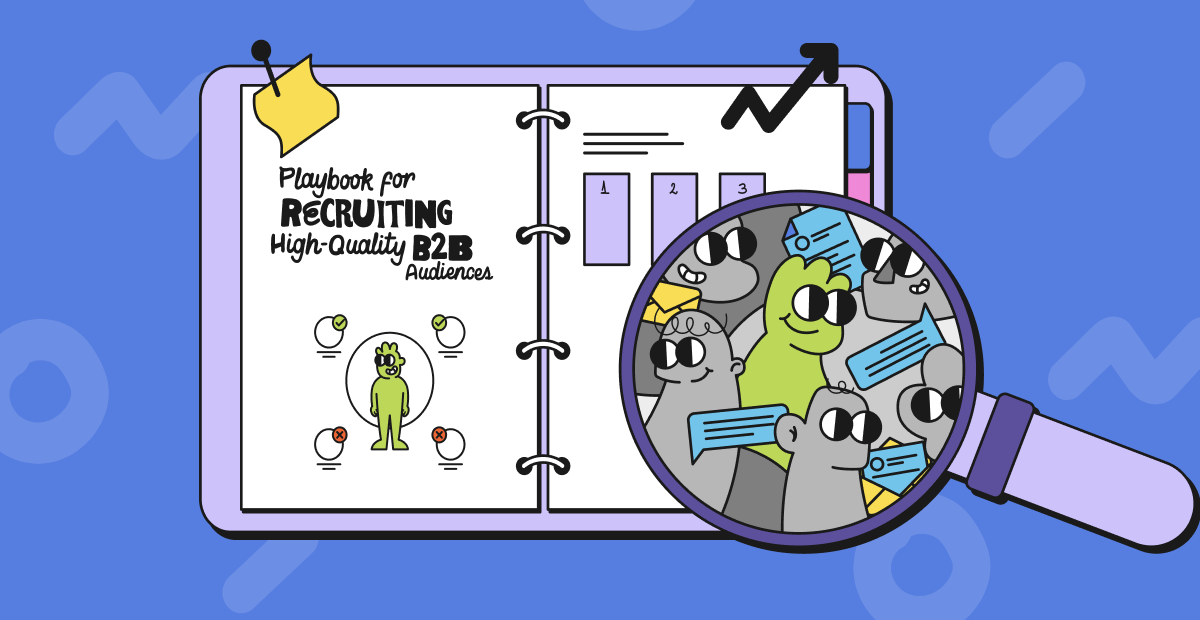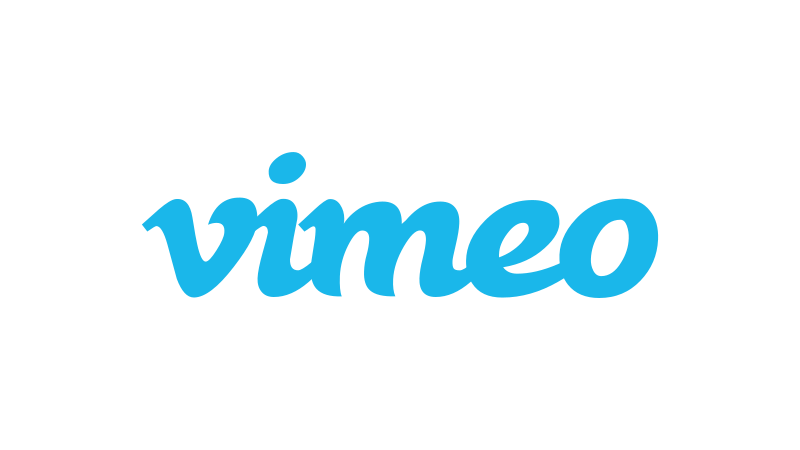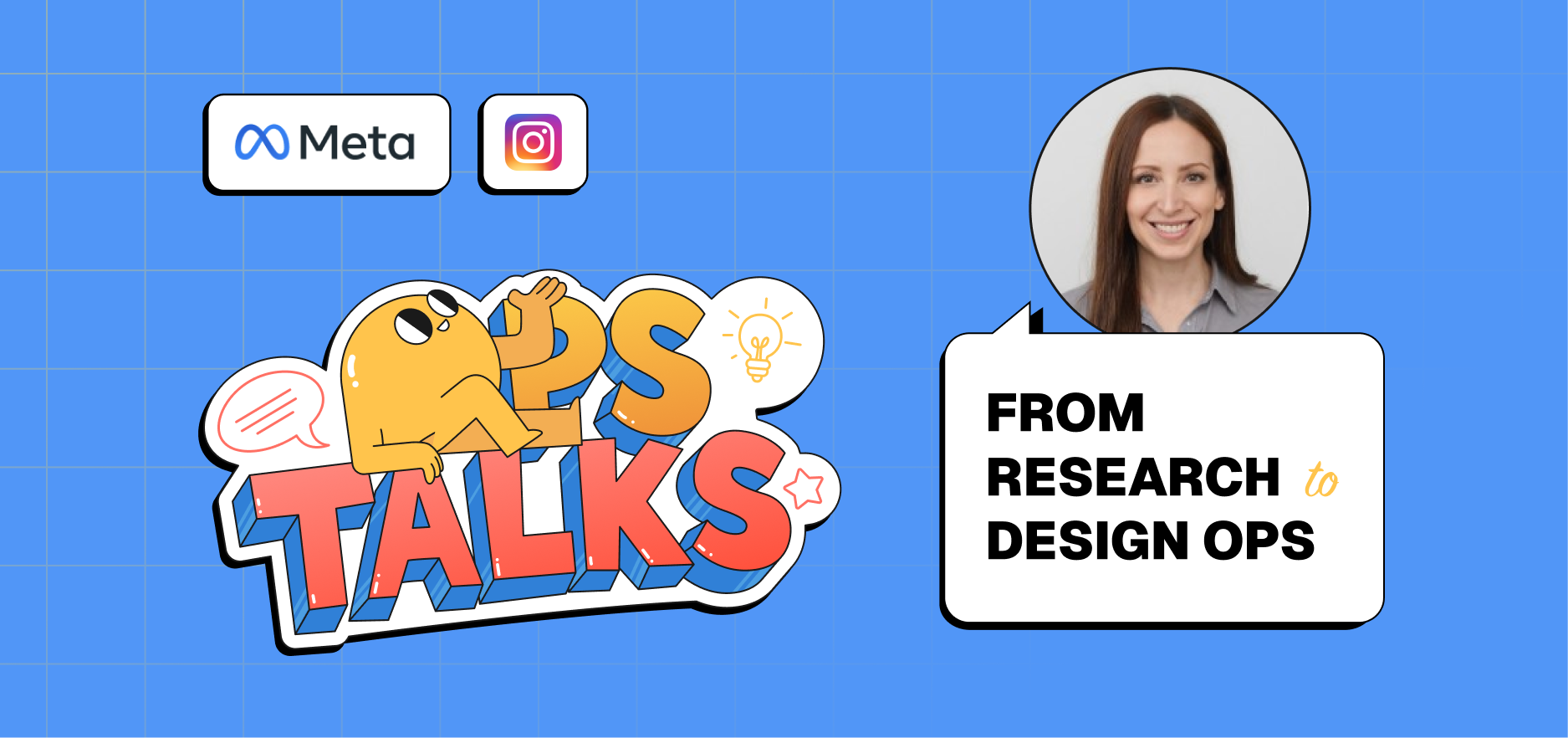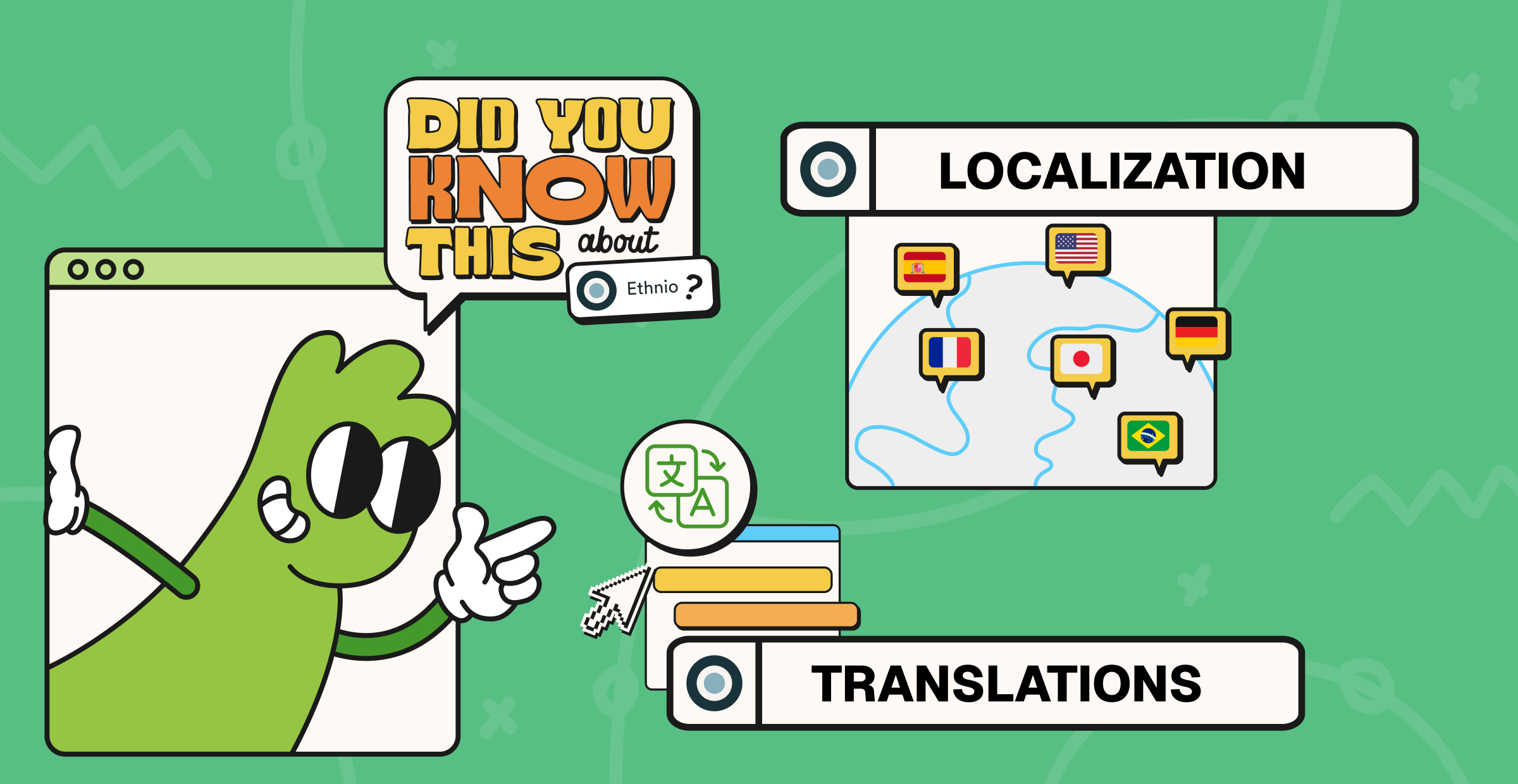Struggling to recruit the right B2B participants for UX research?
B2B recruiting is niche, slow-moving, and high-stakes. Busy schedules, strict access, and hyper-specific criteria create real bottlenecks.
Markiyan Matsekh, former Sr. Director of Product at Vimeo, reflects on leading a $100M+ ARR enterprise product with a team of 60+ PMs, engineers, designers, and analysts:
When I started working on Vimeo’s Enterprise offering, coming from the world of B2C products, I encountered a challenge: it’s harder to access the users in B2B than in the B2C world.At Ethnio, we get it. B2B may differ from B2C, but the principle is the same: find the right audiences. Unlike most guides on this topic that push their own external panels, we don’t sell participants, run panels, or respond to RFPs—we only highlight where our product actually adds value so UXRs, PMs, design leads, and ReOps teams can:
Apply agnostic strategies that work across budgets, research methods, tools, and participant pools
Access pro tips for reaching hard-to-find audiences, including Intercepts
Follow best practices to verify, retain, and scale participant recruitment for long-term impact in niche B2B/SaaS environments
Pro tip:
Don’t reinvent the wheel for every study. Rally your UXR team with ResearchOps capabilities—powered by a robust user research CRM and Intercepts—fully integrated into your existing tech stack. Manage, sync, and govern participants for both qualitative and quantitative studies, all in one platform.
Understanding B2B vs B2C participant profiles
In UX research, participant recruitment usually falls into two categories: Business-to-Consumer (B2C) and Business-to-Business (B2B).
Vitaly Friedman, who’s been improving UX for complex systems across global organizations for nearly two decades—including work with the European Parliament, OTTO, and Zalando—offers a good lens on the key distinction:
In B2B, people buying a product are not always the same people who will use it.That single point drives a lot of complexity. With B2B, we’re balancing the perspective of buyers with that of the actual users—two groups with very different goals. In B2C, the buyer and the user are usually the same.
Before we talk recruitment strategies, we need to be crystal clear on what makes these participant profiles different and what to capture from each.
Business-to-Consumer (B2C)
B2C recruitment engages everyday consumers who use products personally. These participants are typically easier to reach and can be profiled using broad demographic and behavioral criteria.
Example Participants:
College student using a new educational app
Stay-at-home parent testing a new kitchen appliance
Fitness enthusiast evaluating a new wearable device
When defining study goals, it’s important to capture key attributes of your desired participant pool:
Demographic Information
Age range
Gender
Income level
Occupation (e.g., employment status)
Geography (e.g., region, urban vs. rural)
Behavior
Purchasing habits and patterns (e.g., frequent buyers, occasional buyers, deal-seekers)
Brand loyalty (e.g., promoters, brand switchers, first-time users)
Types of products or services used (e.g., competitor products, multiple products)
Usage rates (e.g., heavy, moderate, light)
Lifestyle & Values
Lifestyle (e.g., fitness enthusiast, early adopter, eco-conscious consumer)
Beliefs (e.g., health, budget, comfort, sustainability)
Interests (e.g., fashion, travel, sports, gaming)
Note: demographics alone rarely give the full picture. Combine with behavioral and lifestyle attributes for more accurate profiles.
Business-to-Business (B2B)
B2B recruitment engages professionals using products in a work context. Unlike B2C, the research focus is on business impact: revenue growth, cost efficiency, operational effectiveness.
Recruiting here is harder. Participants are more specialized, busier, and often sit within organizational constraints.
Example participants
B2B customers are engaged based on their professional roles, industry experience, and specific skill. Below are examples of B2B participants:
Software engineer with specific experience in tool or language
Marketing manager evaluating a new analytics software
Healthcare professional assessing a new patient management system
In addition to B2C-like demographic and behavioral factors, B2B participants have specific job responsibilities and skill sets:
Job roles:
Job titles (e.g., their official work titles and seniority level)
Work responsibilities (e.g., How does their workflow look like?)
Company or workplace context:
Industry type (e.g., Technology, healthcare, real estate, finance)
Size of the company (e.g., Number of employees, annual revenue)
Market position (e.g., Leaders, niche players, disruptors)
Behaviors:
Jobs-to-be-done and desired outcomes
Pain points and challenges
Procurement process and tech stack/usage
B2C vs. B2B at a glance
Attribute Type | B2C | B2B |
Demographics / Professional Role | Age, gender, income, occupation, geography | Job title, seniority, responsibilities |
Behavior & Goals | Product usage patterns, purchasing habits, brand loyalty | Jobs-to-be-done, desired outcomes, pain points, workflow constraints |
Lifestyle / Company Context | Hobbies, values, lifestyle preferences | Industry, company size, market position, tech stack, procurement influence |
Pro tip
Tie participant criteria directly to your research goals.
In other words: don’t just look for audiences—look for the right high-quality audiences.
Why? Because the value isn’t in volume, it’s in relevance. High-quality participants give you actionable insights that influence product decisions, de-risk launches, and ultimately drive stronger impact at the platform and business level.
Common challenges in B2B recruiting
Recruiting a senior product manager at a mid-market SaaS company who runs lifecycle campaigns and uses Salesforce every day? That’s not a one-week job. It can take weeks—or sometimes months. If you’ve hit that blocker, you’re not alone.
Here’s why B2B recruiting is often the Achilles’ heel of qualitative research:
Fewer Fish in the Sea
B2B studies demand hyper-specific participants. You’re not just looking for “a marketer”—you might need someone at a Series B SaaS company, running lifecycle campaigns and using a particular CRM. The pool is small, so precision matters.
Drafting Precise Screeners
A title like “manager” or “lead” doesn’t tell you enough. Are they hands-on with the tool or purely strategic? Screen for actual responsibilities and expertise, not just titles.
Scheduling Senior Professionals
The higher the role, the harder it is to pin down time. Packed calendars, global time zones, and shifting priorities make scheduling a challenge. Expect longer lead times, reschedules, and occasional no-shows.
Money Isn’t Always Enough
A $100 gift card might motivate a consumer, but senior B2B participants respond to real value—exclusive insights, professional relevance, or a frictionless experience that respects their time. Strategic engagement is far more effective than incentives alone.
Privacy and Compliance Roadblocks
NDAs, security approvals, and enterprise compliance reviews can slow recruitment. Some professionals simply won’t participate unless processes are airtight.
The Messy Reality of Businesses
B2B workflows are complex and inconsistent. Teams may use different tools or processes—even when solving the same problem. Products may evolve from single solutions into sprawling platforms. Participants will reflect that complexity: no two organizations are structured the same way.
Broader Realities of the B2B Space
Unlike B2C, you can’t cast a wide net. Testing a project management tool, for example, requires someone who not only holds that role but has hands-on experience with similar tools. Busy professionals won’t stumble into a study—they need relevance, trust, and purpose.
Other realities to keep in mind:
Research fatigue: Businesses are inundated with requests; relevance and trust are key.
Gatekeepers: Assistants, coordinators, or admins often stand between you and participants.
Risk aversion: Companies are cautious about sharing sensitive information.
High cost: Targeting senior roles or niche segments can be expensive.
Recruiters need time to screen, pre-qualify, and schedule participants. The process is often lengthy and costly—but worth it. High-quality participants provide insights that directly influence pricing, packaging, adoption, and business strategy.
👉 That’s why the next step—finding the right strategies to engage these participants—is critical.
Rally your UXR team with these 5 B2B recruitment best practices
Use these four foundational practices to ensure your recruiting is effective now and efficient over time (saving you a lot of future headaches).
1. Recruit niche audiences with web or app intercepts
Sometimes the best participants are already inside your product or service. Intercepts on your website or app let you reach B2B audiences in the right context, at the right moment. Place intercept popups on your website, app, or digital products to target specific user behaviors. Use contextual messaging to invite the right audience at the right moment.
Combine intercepts with screeners and targeting attributes to ensure only qualified participants engage.
This approach is ideal for reaching hard-to-find professionals who might not respond to standard outreach.
✅ Capture niche users who are actively engaging with your product.
✅ Segment them by behavior, role, or account type for targeted invites.
✅ Reduce reliance on cold outreach or external panels.
💡 Pro tip from Ethnio: Use Intercept Groups to set up advanced filters and recruit even the hardest-to-reach professionals directly from your product experience.
2. Use screeners thoughtfully
Your screener is your strongest filter for attracting the right people—and gently screening out the wrong ones. For B2B, “right” usually means highly specific.
✅ Focus on responsibilities, not titles (e.g., “Leads procurement decisions for cloud-based software” vs. “Procurement Manager”).
✅ Add behavior-based questions to surface hands-on experience, tool usage, and decision-making power.
✅ Pilot your screener internally or with a test batch to make sure it works in the real world.
💡 Pro tip from Ethnio: Write screeners that read like real conversations. Ditch the buzzwords—clarity gets you better candidates. [See our template →]
3. Offer meaningful incentives
Cash is fine—but often not enough, especially for senior professionals. A compelling incentive should:
Respect their time (e.g., tiered incentives for multi-phase or in-depth work).
Communicate value: Will participants get early access to findings? Will their input shape a tool they’ll actually use?
Sometimes a personalized summary of insights is more valuable than a gift card.
💡 Pro tip from Ethnio: Not sure how much to pay or what else sparks participation? Try our Incentive calculator.
4. Build a panel for long-term value
Panels let you:
Organize participants by role, company type, or behavior
Track participation history and incentive preferences
Re-invite trusted participants for longitudinal or follow-up research
Reduce fielding time and build stronger, ongoing relationships
Once you’ve found high-quality B2B participants, don’t let them disappear into a spreadsheet. The best B2B recruiting strategy is the one you don’t restart from scratch every time. When you find high-quality participants:
Track their involvement and feedback history.
Create groups based on role, industry, or behavior.
Use panels to manage engagement, prevent fatigue, and build trust.
💡 Panel management in Ethnio powers teams to:
Leverage participants from your own networks or lists using:
Shareable links embedded in emails, InMail, popups, or CRM campaigns
Direct invitations via LinkedIn InMail or Slack groups
Warm introductions from your Sales or Customer Success teams
Product or content page intercepts to capture participants in-context
5.Use Ethnio targeting attributes and screeners
With robust targeting filters and custom screeners, you can:
Pinpoint professionals by job title, company size, industry, tools used, and more.
Add behavior-based questions to find people who have actually done the work—not just claimed a title.
Layer screeners with logical flows to make qualification fast and seamless.
💡Bonus:
Ethnio’s filters are especially powerful for hard-to-reach B2B personas, like technical decision-makers or industry-specific roles.
Channels to recruit B2B participants
Finding high-quality B2B participants requires more than a single email blast. Precision, context, and respect for busy professionals are essential.
1. Intercepts
Intercepts are your secret weapon. Web, app, or digital product intercepts let you reach participants in context. Pre-fill screening questions with customer data and combine with behavioral targeting. This reduces reliance on cold outreach or external panels. Like Intuit and CarMax successfully run live recruiting through intercepts to reach niche participants.
Say goodbye to professional survey respondents—or bots.
2. Ethnio Targeting Attributes & Screeners
Use advanced filters to pinpoint professionals by role, company size, industry, tools used, and workflow experience. Behavior-based questions ensure candidates have hands-on expertise. Logical flows make qualification fast and seamless, even for hard-to-reach personas like technical decision-makers or specialized industry roles.
3. Leverage your own networks
Your internal networks are gold. Use:
Shareable links via email, InMail, Slack, or CRM campaigns
Direct invitations from Sales or Customer Success teams
Warm introductions for trusted, contextually relevant participants
4. Build private panels for long-term value
Track participation history, incentive preferences, and engagement. Organize participants by role, company type, or behavior. Re-invite trusted participants for longitudinal studies—reducing fielding time while building stronger ongoing relationships.
Think of it like a VIP list for research—future studies will thank you.
Parting thoughts
B2B recruiting is hard—but the right strategy makes it achievable. Fewer participants, busy schedules, and ambiguous job titles are challenges you can overcome with intentional preparation, cross-functional alignment, and robust tools. High-quality participants become research MVPs whose insights shape products, platforms, and enterprise decisions.







